Changing the Guard in Undergraduate Medical Education
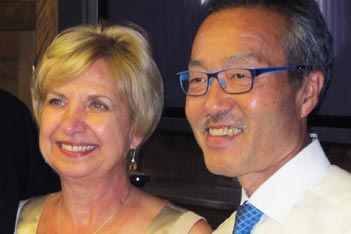
Carmela Calorendi with Ron Kodama
Having served as Director
of Undergraduate Medical
Education (UME) in the
Department of Surgery for
7 years, David Backstein
has stepped down from
this position to focus on
his academic position as
Head of the Division of
Orthopaedics at Mount
Sinai Hospital. We take this opportunity to thank David
sincerely for his tireless efforts and devotion to undergraduate
medical education, and for putting into place a new
curriculum for our students. Following a city-wide search this summer, I am pleased to report to you that George Christakis has been appointed as the new Director of UME. George is Professor of Cardiac Surgery with a long standing devotion to undergraduate education.
Assisting George Christakis with the UME program
will be pre-clerkship coordinator, Ron Kodama, and
newly appointed UME Coordinator, Shibu Thomas.
Shibu is following in the footsteps of Carmela Calorendi
who served capably in this role for 22 years. We would
like to thank Carmela sincerely for her many years of
service to the Department, and for assisting with the
education of countless hundreds of medical students
over those years.
Jim Rutka
Shibu Thomas
COORDINATOR UNDERGRADUATE SURGICAL EDUCATION

Shibu Thomas |
Undergraduate Surgical Education
Coordinator Shibu Thomas, working
with George Christakis,
has taken a close look at the
experience of our students and
has made several useful recommendations.
The Crash course,
which helps assure that students
enter their clinical rotation with
sufficient background information
"was excellent, but students
couldn’t maintain their focus when the sessions ran from 8
AM to 6 PM". Shibu and George shortened the program
to four days, running from 9 until 5. The fifth day is spent
at the Li Ka Shing simulation centre in a hands-on trauma
course, coordinated by Jameel Ali and his colleagues at St.
Michael’s Hospital. This has been highly evaluated by the
students. The next seven weeks are spent in 3 sub-rotations
on surgical specialties, including one in general surgery.
All of the students are given an initial orientation on
arrival and a handbook prepared by Shibu. They report that
some of the rotations are "heavy on SCUT work (service
component unrelated to training)", and they feel that they
are not really perceived as part of the surgical team. This
is an important insight e that requires remediation. At the
mid- point of their rotation, there is a centralized lecture
day with 2 hours of pediatric surgery, 2 hours of surgical
radiology and one to three hours of palliative care. They
also participate in an ungraded practice National Board of
Medical Examiners exercise. At the end of the rotation, the
students take the National Board of Medical Examiner’s test
for credit. Their grade is based on an oral exam, the NBME
exam and the ward evaluation, one third each. They are also
required to bring their TRes, a log of their encounters and
procedures, which can be entered from a portable device
such as an i-phone or Blackberry.
Shibu was born in India, where his father was on attaché
who traveled widely, giving Shibu a very varied life experience.
He received a Master’s Degree in English at Bangalore
and has worked as a copywriter and in administrative positions
in healthcare on the wards and in the ICU within the
University Health Network. He served as administrative
coordinator for Plastic Surgery before taking his present
position. He is enthused about his undergraduate responsibilities.
He is a skilled medical writer who has prepared
articles for U Toronto Medicine and other publications.
M.M.
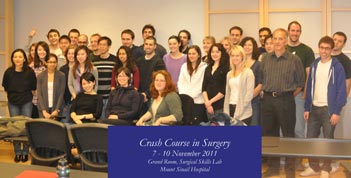
Crash Course in Surgery Nov. 11-3
TOP 10 POINTS FOR FACULTY IN THE DEPARTMENT OF SURGERY TO REMEMBER ABOUT UNDERGRADUATE MEDICAL EDUCATION
- Know the goals and objectives of the surgery
program
- Know the objectives of the course in surgery you are
teaching
- Be familiar with key policies about student injury
(e.g. Needlestick, student mistreatment)
- Get involved as a Program Based Learning tutor,
mentor or scholar
- Take part in faculty development in the
Department of surgery
- Watch your students interview and examine
patients in the clinic
- Give students feedback regularly
- Be supportive and positive as role models
- Help students understand what careers in surgery
are about
- Complete your student evaluations in a timely
manner
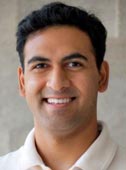
Adam Rosanally |
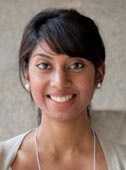
Sindu Govindapillai |
Congratulations to our Year 3 students
Adam Rosanally (Rotation
E, Peters Boyd Academy) and
Sindu Govindapillai (Rotation
D, Wightman-Berris Academy)
who scored 94% and 90%
respectively, on the National
Board of Examiners (NBME)
Surgery examination.
A truly outstanding effort.
Both Adam and Sindu need to
be commended for the attitude,
hard work, dedication and aptitude
that these scores reflect.
Good luck with your studies
and continued success in
your future endeavours.
Shibu Thomas |
|
George Christakis
DIRECTOR UNDERGRADUATE SURGICAL EDUCATION
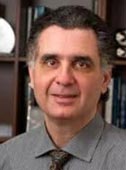
George Christakis
|
George Christakis has been interested
in surgery and surgical education
since medical school. He
received all of his medical and
surgical training at the University
of Toronto. Clerkship had the
biggest impact on him, particularly
exposure to surgeons Ulo
Ambus, Bryce Taylor and John
Palmer. He was inspired by the
broad knowledge and critical
thinking of these insightful role models.
George has always liked teaching undergraduates.
He has written the learning objectives for the clerks
on surgery, and participated in problem-based learning
exercises with the first year students since 1990. He was
the clerk coordinator at Sunnybrook, which provided
excellent background for his current position. He likes to
read history, and is currently reading "A World without
Islam" by Graham Fowler. His children, Theodore, 13,
Nicole, 12 and wife Monique travel, camp, and canoe
together during vacation time.
M.M.
A message from George
OUR UNDERGRAD STUDENTS HAVE CHANGED: HAVE WE?
Those who know me know I don’t mince words. You’ll
probably read some seemingly sacrilegious statements
here. But please bear with me, I have a point. In fact, this
is a result of a personal introspective exercise that made
me reflect, ponder and then become charged with energy
to institute positive change. I hope that for at least a few
of you this will be a reason to look at things from a different
perspective.
It has been a few months since I’ve taken on this role. I
am daily reminded of, humbled, and applaud the efforts
and insight that my predecessor, David Backstein and his
team brought to the Department of Surgery education
portfolio.
I know also, that there are some challenges and
issues and shortcomings in the way we have been doing
things. While the upcoming accreditation in May 2012
is a very important milestone for us, I see change as
far more important as we seek to provide our students
with an educational experience that is compelling,
engaging and on par with the best in the world. The
recent Independent Student Analysis (ISA) (www.md.utoronto.ca/Assets/FacMed+Digital+Assets/ ume/Accreditation/ISAfinal.pdf?method=1) findings
are just manifestations of an underlying malaise in
Undergraduate Education in the Department of Surgery.
The following are some of my thoughts (in the form of,
hopefully, thought-provoking questions) on this issue
that I’d like to share with you.
Are we as University-appointed faculty seriously thinking
about delivering quality education?
Is the level of interaction that we provide our undergraduate
students on par with one that we (or our children)
would be happy receiving?
Technology has changed, society has changed, and
paradigms have shifted. Have our teaching methods
effectively changed for the better?
Are we turning away some of the brightest young
minds from a career in surgery by our perceived aloofness
to clerks? This may be perception, but that is what may
be often taken as reality.
Shouldn’t education in all its facets be the raison d’être
of the University and the Department of Surgery in general
and Undergraduate Education in particular?
In the upcoming issues of Surgical Spotlight, I hope
to share with you a few ideas and policy changes - some
mine, many from my colleagues in Surgery and a few
mandated by the University UME.
This is not change that can be made by a few people,
in weeks or months. It requires passion, perseverance,
and steadfast purpose. I seek your assistance, encouragement,
advice, support and best wishes as we embark on
this exciting, important, and monumental endeavour -
one little and progressive step at a time. Thank you for
your contributions to undergraduate surgical education.
T-RES FORM
At the Clerkship Committee Meeting, chaired
by Clerkship Director Undergraduate Medical
Education Anita Rachlis, one of the points that was
stressed at that meeting was the importance of the
T-Res form being completed by our clerks.
I find this process to be very helpful as it gives us
a checklist of the encounters and procedures that the
clerks need to have been exposed to as part of their
surgery rotation. If you are the "final preceptor," i.e.
in the third surgical rotation of the 8 week period, we
must have a plan to help students fulfill all the goals
set out on the checklist, in the rare cases where a student
has not had exposure to one of the clinical goals.
At the time of your clerk’s ward evaluation,
please remember to ask them about this form (also
referred to as Form 62 or 064)? Clerks have already
been instructed to bring an updated form with
them to their mid-term evaluation.
For your reference, T-Res forms can be viewed at:
https://www.portal.utoronto.ca
Thank you,
George Christakis
Director, Undergraduate Education
Department of Surgery, Faculty of Medicine
University of Toronto
|
1. T-RES
T-Res is a mandatory component of the course and it lists the essential encounters and procedures that every clerk is
expected to complete during their rotation. See image (Fig.
1) to see the manual logging sheet. The progress of a clerk’s
T-Res compliance should be monitored at the time of the
Midterm subrotation evaluation - see below.
2. Midterm subrotation evaluation form
This is used to provide formative feedback to the student at the midpoint of every subrotation.
3. MedSIS timeline for marks
Four (4) weeks after rotation for components, six (6) weeks
for final marks. As per UME policy, component marks
need to be published for students 4 weeks after their rotation.
This means all evaluations forms need to be completed
on MedSIS before this milestone. Optimally, all evaluations
should be completed within one week of a clerk’s subrotation.
4. UME teacher manual
This is a very useful resource and is available online at
http://www.md.utoronto.ca/handbook.htm
|